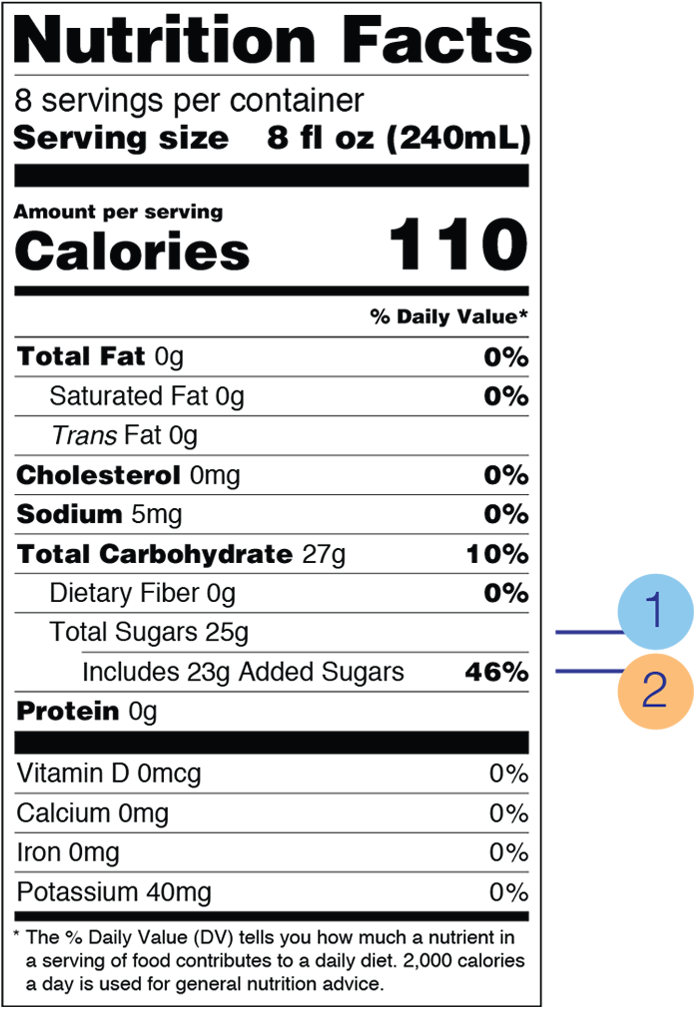Added Sugars
Based on the rules put forth by the FDA effective July 26, 2016, commercial Kombucha producers in the United States are required to indicate the sugar they add to the fermentation process as “Added Sugars.” However, the amount required to put on the label is AFTER fermentation has occurred.
To be in compliance with this rule, it is advised that Kombucha producers in the United States submit their products to a third party lab for sugar testing.
Clear records and scientific documentation that demonstrate the accurate amount of sugar grams in the final products along with a narrative of why the amount is different than the starting sugar are required to be kept on file.
Any Kombucha producer that adds juice concentrate, sugar or sugar substitutes to their final product would need to also include that information as part of the “Added Sugars” amount on the label.
RECAP:
- The amount of sugars present must be declared as both TOTAL and ADDED sugars (21 CFR 101.9(c)(6)(iii)).
- Added sugars may not exceed the Total sugars amount listed on the label.
- Added sugars = the amount of sugar remaining in the product AFTER fermentation.
- Clear documentation and narrative are kept on file and provided upon request.
- Any other sugars added in the flavoring stage are also to be included as ADDED SUGAR
- sugars (free, mono- and disaccharides) (this would included fructose, sucrose, and glucose)
- sugars from syrups and honey
- sugars from concentrated fruit or vegetable juices that are in excess of what would be expected from the same volume of 100 percent fruit or vegetable juice of the same type
The new rules put forth by the FDA regarding added sugars are listed here for reference (important details bolded by KBI):
- Requiring the declaration of the gram amount of “added sugars” in a serving of a product, establishing a Daily Reference Value (DRV), and requiring the percent Daily Value (DV) declaration for added sugars;
- Changing “Sugars” to “Total Sugars” and requiring that “Includes `X’ g Added Sugars” be indented and declared directly below “Total Sugars” on the label;
- The rule requires a manufacturer with sugars added before and during the fermentation process to make and keep records of added sugars necessary to determine the amount of added sugars present in the finished food. The rule requires manufacturers of such foods to make and keep records of all relevant scientific data and information relied upon by the manufacturer that demonstrates the amount of added sugars in the food after fermentation and a narrative explaining why the data and information are sufficient to demonstrate the amount of added sugars declared in the finished food, provided the data and information used is specific to the type of fermented food manufactured.
- Establishing a compliance date of 2 years after the final rule’s effective date (7/26/16), except that manufacturers with less than $10 million in annual food sales have a compliance date of 3 years after the final rule’s effective date. (For more details, see part III.)
ALL BRANDS WILL NEED TO BE IN COMPLIANCE WITH THIS LABEL CHANGE
Example of where Added Sugars to be noted on label:

Serving Size
II.3 How Does the Rule Define Single-Serving Container? A single-serving container is a product that is packaged and sold individually and contains less than 200 percent of the applicable reference amount for that product (21 CFR 101.9(b)(6)). The entire content of a single-serving container must be labeled as one serving (21 CFR 101.9(b)(6)). Under the final rule, regardless of the size of the RACC, all products that are packaged and sold individually and contain less than 200 percent of the applicable reference amount for that product must be labeled as a singleserving container (21 CFR 101.9(b)(6)). However, if the product is more than 150 percent and less than 200 percent of the applicable RACC, the manufacturer may voluntarily provide an additional on the Nutrition Facts label, to the left of the column that provides nutrition information per container (i.e., per serving). The voluntary column would list the quantitative amounts and the percent Daily Value (DV) per common household measure that most closely approximates the RACC (21 CFR 101.9(b)(6)).
Basically you will need to decide the serving size of your Kombucha. So if you currently sell at 16oz size, that would need to be considered a single serving and the full amount of calories, sugar grams etc would need to be listed for that size. If your serving size is 10oz and you sell a 16oz bottle, the container will need the info for 10oz product and may voluntarily include nutrition info per container (meaning for the full amt in the bottle).
We’ve seen many brands change from 16oz to a smaller serving size (10-14oz)